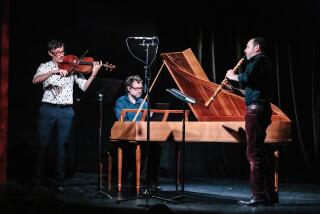NEW ORLEANS BASE : JAZZ BAND TO PLAY AT COLLEGE
- Share via
To hear Allan Jaffe tell it, Preservation Hall has lived up to its name admirably.
For 25 years now, the New Orleans nightspot has provided a home for the early jazz styles that grew up around Louisiana’s delta region at the turn of the century. Jaffe, who owns the hall (with his wife, Sandy), believes the aging French Quarter hall has helped save the music from extinction.
In addition to about 400 performances presented at the hall every year by the five Preservation Hall jazz bands, three of the bands regularly tour the United States. A visit to the Southland brings the music of Preservation Hall to the gymnasium of Saddleback College in Mission Viejo Saturday at 8 p.m. and to UCLA’s Royce Hall July 6 at 8 p.m.
The high-spirited New Orleans-style jazz, which features a steady rhythm under ensemble and solo improvisations on a simple melody, began to decline in popularity after World War I. “It used to be, in New Orleans, that there was music in literally hundreds of places, and this was something that encouraged musicians to continue playing,” Jaffe explained by telephone from New Orleans. “As these venues started dropping, the music also began to disappear.”
Art dealer Larry Borenstein fought the trend by founding Preservation Hall in 1961, and the Jaffes took over soon thereafter. Many of the musicians displaced by the waning interest in jazz were contemporaries of such early greats as Louis Armstrong, King Oliver, Bessie Smith and Jelly Roll Morton, and Preservation Hall gave them a place to play. Some are still going strong.
For example, there are the Humphrey brothers, both of whom play in the band now on tour. Trumpet-playing Percy, 81, and clarinetist Willie, 85, first performed together publicly with their grandfather’s band at a Memorial Day service in 1911. Percy went on to lead his own dance orchestra as early as 1925; Willie, a boyhood friend of Louis Armstrong, played with such luminaries as Ma Rainey and King Oliver.
Preservation Hall features many such slices of living jazz history, but time has taken its inevitable toll, and many of the early hall regulars are gone. “I wish all the same musicians were playing,” he said. “Most of the older musicians were really unique--it’s tough to find somebody to replace them.”
But Jaffe is encouraged by what he sees as a resurgence of interest in early styles of jazz. “There are young musicians who are playing this music,” Jaffe said, and many of them are in New Orleans. “For a long time you could find a lot more young musicians playing this music in Los Angeles than in New Orleans, but that’s not true anymore.”
Some of these musicians have gone on to create new locations for the music in New Orleans restaurants, hotels and nightclubs. It is a development Jaffe applauds, and he says much of the credit for the renewed interest should go to Preservation Hall.
“My feeling was that if we could have an audience for the music, then the music would survive,” Jaffe said. “I think that we have introduced a whole new group of people to this music. There is a whole new audience both here (in New Orleans) and around the world.”
Preservation Hall itself has become something of a national landmark; its plain wood benches and stark decor have remained virtually unchanged over the club’s 25-year history. Shows at the hall, usually capped off by a rousing rendition of “When the Saints Go Marching In,” are legendary, and long lines outside the club are a regular sight.
Jaffe is proud of the hall’s still-growing reputation. “It is something that we were looking for, something I thought we deserved and something that I never thought we would get.” As evidence of Preservation Hall’s national stature, Jaffe revealed that the band now on tour has just been asked to perform at a White House party for congressional leaders Aug. 14. It will be the first White House appearance for a Preservation Hall jazz band.
The White House date will close the current tour of the band, which features the Humphreys, James Edward (Sing) Miller on piano, Narvin Henry Kimball on banjo, Frank Parker on drums, Frank Demond on trombone and Jaffe himself on tuba. Jaffe, 50, grew up in Pennsylvania, far away from the delta.
“I started off listening to records, and I felt that this was a music that really had to be heard live. I wanted to live where it was played,” he explained.
“The music is very honest, very simple. I think it’s the most exciting music in the world.”
More to Read
The biggest entertainment stories
Get our big stories about Hollywood, film, television, music, arts, culture and more right in your inbox as soon as they publish.
You may occasionally receive promotional content from the Los Angeles Times.










